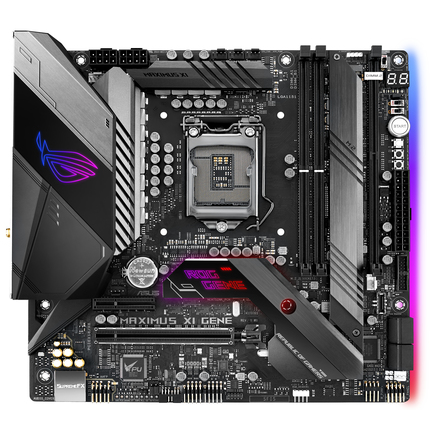Asus ROG Maximus XI Gene Review: Dual Capacity RAM Meets DIMM.2
Why you can trust Tom's Hardware
How We Test
Intel Turbo Boost ratios usually scale downward as more cores are deployed, and in the case of the Core i9-9900K in our updated test right, that drop is from 50x to 47x (5 GHz to 4.7 GHz). Retail motherboard manufacturers have employed an automatic overclocking scheme that pushes the CPU’s maximum Turbo Boost ratio, regardless of the number of loaded cores, and we have always disabled that feature.
Furthermore, we perform our basic performance and power tests with XMP disabled, since certain motherboards re-enable the CPU overclock in tandem with XMP. Yet most of that is historical since today’s boards have that feature disabled by default when using a Core i9-9900K: It simply draws too much power and reaches its own thermal threshold too easily for such overclocks to work reliably. That recent development hasn’t changed our test methods.
One thing that has changed from the previous processor generation is that more boards are applying power throttling, including both Asus boards we’ve tested recently. While Asus’ throttle setting doesn’t noticeably impact most of our real-world benchmarks, it corrupts our synthetic benchmark results as well as our power & heat measurements. We did a full performance comparison with the default power throttling both enabled and disabled in our Maximus XI Hero Review before deciding to test the Maximus XI Gene only with its power limited uncapped.
Our memory kit contains four single-rank DIMMs, but the ROG Maximus XI Gene has only two slots. While our real-world benchmarks are optimized for 16GB or less RAM, the biggest performance difference we’ve seen between motherboards corresponds to the number of memory ranks deployed, two or four, with the handicap going to dual-slot Mini ITX boards.
Yet the number of memory slots also impacts the amount of memory that can be installed, and the later became Asus’ focus when promoting a technology that effectively overcomes the dual-slot limit by stacking a pair of modules in a single package. Called “Double Capacity DIMMs”, Asus sent a set for today’s tests.
The above four-rank DIMMs can’t overcome the CPU’s memory controller limit of eight ranks, and since four ranks times two DIMMs is eight, Asus could only make these compatible with its own two-DIMM boards. Asus keeps the technology within its Republic Of Gamers line by including support for it on the ROG Maximus XI Gene, ROG Maximus XI Apex, and ROG Strix Z390-I Gaming. You may have noticed that these Zadak parts are gloriously displayed upon G.Skill’s Trident-Z Royal demo case: Though one might call that a “poke” toward the other company to offer double-capacity DIMMs, the fact remains that this bit of swag (which came with G.Skill's Royal RAM review kit) has made it significantly easier to photograph lit modules.
Comparison Hardware
Since we’re testing the Maximus XI Gene both in the default two-rank memory configuration of our Mini ITX reviews and an advanced memory configuration using additional ranks on two DIMMs, we’re including the Maximus XI Hero’s four-DIMM results in our charts.
Get Tom's Hardware's best news and in-depth reviews, straight to your inbox.
The rest of our hardware and software is carried over from our Maximus XI Hero Review.
MORE: Best Motherboards
MORE: How To Choose A Motherboard
MORE: All Motherboard Content
Current page: How We Test
Prev Page Software and Firmware Next Page Benchmark Results and Final Analysis






